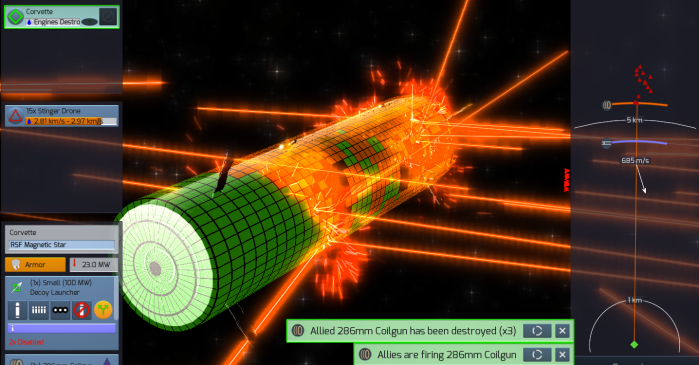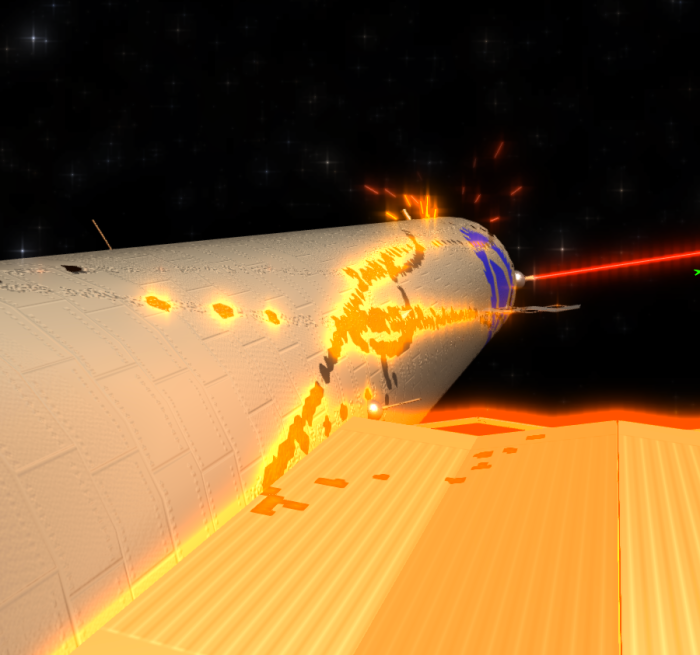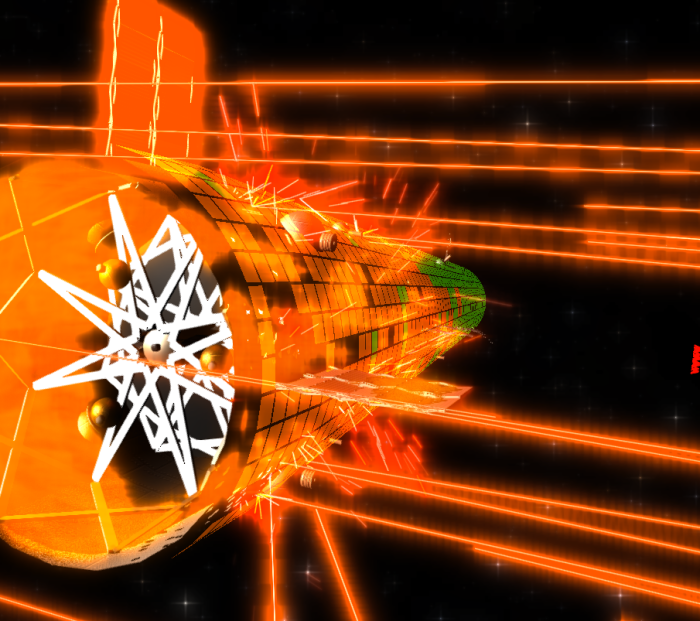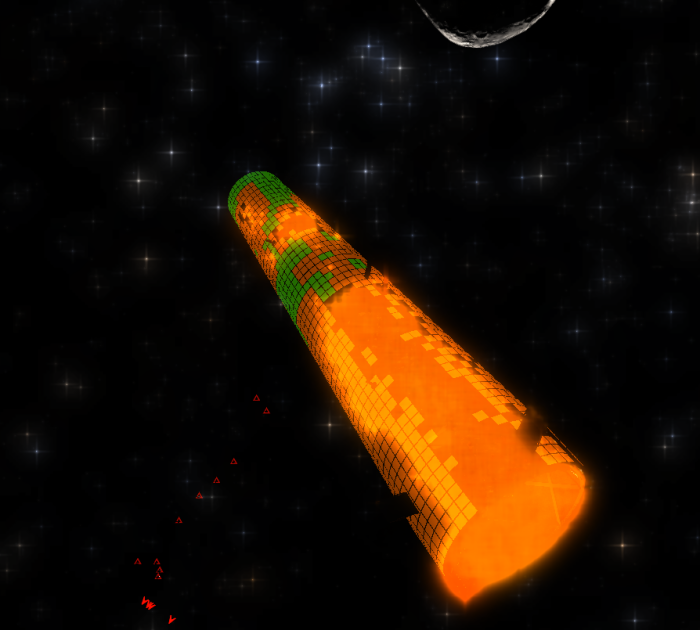Armor is one of the simplest things to manufacture, yet it holds some of the most complex results.

A 5 cm plate of steel is rather easy to produce, but analyzing how well it will perform under a wide variety of types of damage in different orders is rather difficult.
There are three main methods of damage: projectile, photonic, and plasma. Generally speaking, given equal amounts of energy, plasma damage is the least effective in many cases, and projectile damage tends to be the most effective. These differences vary significantly and may even reverse depending on the type of armor, however.
When a projectile hits armor, there are numerous ways that it may affect the armor. If the projectile does not penetrate, it can fracture the armor anyways, either where the bullet hit or on the other side of the armor. It could spall fragments off the inside of the armor, which can cause damage to internal compartments. And all of these scenarios are possible too if the projectile does fully penetrate.

Of course, with hypervelocity projectiles, in many cases, the projectile will shatter into plasma upon hitting. Not only that, the armor may shatter into plasma too. An interesting effect of this (which is modeled in Children of a Dead Earth) is that in certain cases, more armor can detrimental. Too much armor can get shocked into plasma or spallations and inflict even more damage than a thinner armor plate.
Laser damage is somewhat simpler. The primary method by which photons inflict damage is by ablating away the armor, causing material to melt, evaporate, or sublimate away.
Alternatively, a pulsed laser could be used to trigger shockwaves from the rapid expansion of the affected armor material. In this way, lasers can be used to inflict mechanical damage on the armor. A very thorough discussion on laser effects on armor can be found here.
Determining a model for how well a piece of armor reacts to every different scenario (or combination of scenarios) is rather difficult. On top of the different types of damage, there are many different kinds of armor materials and design choices.

Material properties that are important to armor materials follow.
The Ultimate Tensile Strength of a material is the capacity of that material to withstand tension, or being pulled apart. The Yield Strength, or the stress point at which plastic deformation of the material begins, is another metric which very important to determining the effect of mechanical damage.
The Density of a material plays a key role in resisting damage, particularly projectile impacts. One interesting point of note is that high density Whipple Shields perform worse due to a greater amount of Whipple Shield material being shocked into plasma, and hitting the main armor.
Against melt ablation by lasers, very different properties are used. Often, material strength is more or less irrelevant against laser damage. Instead, high Melting Points, Boiling Points, and Specific Heat Capacities are of crucial importance for armor to resist heating. All of these quantities allow the material to absorb more energy without failing.
Alternatively, some materials can get away with very poor heat resistance by instead having a very high Thermal Conductivity. If the material conducts heat away fast enough, a laser can dump energy into the material all day and never heat it up, as the material will conduct the heat away to surrounding armor tiles.
And of course, a number of other properties play a minor role in determining damage, like the Elastic Modulus and Shear Modulus. But generally when choosing armor, your main concern should be a high Ultimate Tensile Strength and a high Melting Point.

So with those properties in mind, what material is best to use for armor?
Consider the material used for a single monolithic plate. Common choices are metals like lightweight Aluminum and Titanium, or the very dense Depleted Uranium.
Alternatively, metal alloys like Steel, particularly high strength steels like Maraging Steel make for great armor. However, on Earth, high density is valuable for lower volume, but in space, low density armor is more important, as armor can and will drastically affect your spacecrafts mass ratio.
This means ceramics like Reinforced Carbon-Carbon or Boron Nitride see use everywhere in space. They tend to be somewhat weaker than many high strength alloys, but their low density and resistance against laser damage more than makes up for it. On top of that, they are extremely cheap. In practice, ceramic armor tends to be the most common spacecraft armor.
Synthetic fibers like Aramid, which includes Kevlar, Technora, and Twaron have exceptional strength against projectile damage while having very low density as well. On the other hand, they suffer badly against laser damage, having rather low melting points.
Then there are the more exotic materials. UHMWPE, or Ultra-High Molecular Weight Polyethylene, is a plastic which has enormous strength and incredible low density. Similar to Aramids, though, its melting point is rather low. Nanocomposites tend to very strong as well, but are difficult and expensive to manufacture. And of course, you can use Aerogel in game, though its usefulness as armor is questionable. Same with Metallic Microlattice.
A few materials are omitted, most prominently, Carbon Nanotubes (CNTs) and Carbyne. CNTs promise incredible strength, but with today’s technology, they are limited to bulk use. This entails essentially crushing a pile of CNTs together and hoping for the best, which performs very poorly compared to the strength of a single CNT. It is unclear if achieving CNT strength on a macro scale is possible or just a pipe dream. In all likelihood, they will likely be used as a way to bolster existing material strengths.

But armor is more than just a single plate of the strongest stuff you can find.
Whipple Shields are simple, cheap, and very effective. They are a specialized case of Spaced Armor. A thin plate of low density material spaced out far off from the main armor can shock incoming hypervelocity projectiles into plasma. The purpose of the spacing is to allow time for the plasma to expand into a greater area, and thus spread its damage thin.
In practice, Whipple Shields delay the inevitable. When the enemy is dumping a thousand bullets per minute at you, your Whipple Shield is going to get demolished very quickly. However, they buy you a small amount of time (less than a minute), and those tens of seconds might be exactly what you need to get in close with more powerful, closer range weapons.

Composite Armor is a fancy term for multiple layers of very different materials. As shown above, different materials perform better under different situations, so having composite armor is a way to have the best armor for each situations. In Children of a Dead Earth, each layer can be spaced out as well, combining Composite Armor with Spaced Armor/Whipple Shields.
Sloped Armor is simple, cheap, and absolutely crucial. Simply angling the armor plates can have a tremendous effect on survivability. This is not just because the effective armor thickness increases with the angle, but also because it causes projectiles to ricochet, deform, or deflect. Sloped armor is arguably the most effective defensive measure.
In practice, missiles with extremely pointy faces survived far longer against enemy point defenses than missiles with flat faces. I discovered this when one of my alpha testers pointed out that between two of the smallest missiles, one with a tiny flak payload and one with a tiny nuclear payload, the flak missiles were surviving at 10x the rate of the nuclear missiles. As it turned out, the flak payload with long and thin, and convex armor hull wrapped it into a point, while the nuclear payload with short and fat, leading to a flat face.
All missile designs were given a sharp nose after that.

There are a few more design choices not in Children of a Dead Earth but should be mentioned for completeness.
Slat Armor uses a cheap grid around the armor to deform explosive projectiles. In space, however, most payloads are detonated before colliding, and explosive projectiles are already weak in space. Slat armor is easily defeated by Tandem Charges.
Reactive Armor layers the armor with explosives which detonate outwards when hit. While effective against incoming explosive payloads, again, explosive payloads are not used nearly as much as nuclear payloads and simple projectiles. Additionally, this armor needs to be outside of any Whipple Shield, lest the Whipple Shield blasts out numerous tiles with each expanding burst of plasma. Not a very effective armor if the enemy is carpeting you with bullets. Also defeated by Tandem Charges.
Electric Armor is two plates of armor separated by an electrical insulator, and one side charged. When a bullet hits and closes the circuit between the two plates, the electrical discharge will vaporize the bullet or even turn it into plasma. This would require an additional armor layer beyond the Electric Armor to shrug off the plasma, likely spaced out to let the plasma spread thin. While promising, this technology does not exist in any current form, and its limitations are unclear.

That’s all for armor! Armoring your spacecraft designs is very simple, but the ramifications end up being very complex. And as with many designs, optimal solutions are never as obvious as you may think.
Are internal armored bulkheads possible to build ingame?
So you could, say, stuff some kevlar between your tanks to minimize how many tanks a projectile goes through. Or armor the CIC and a main coilgun specifically.
LikeLike
Internally armored compartments are possible (i.e. adding heavy armor to your crew compartment, or even armoring certain propellant tanks).
Additionally, you can use radiation shields as armor (something one of my alpha testers accidentally discovered) between compartments as well.
LikeLike
So armoring compartments is possible, but not layers of armor BETWEEN compartments?
Also: Is there a deadline, rough or otherwise, for release?
LikeLike
Oops, didn’t read about radiation shields. Can you make radiation shields out of anything, like the armor materials listed above??
LikeLike
Yes, any armor material.
Roughly, within one or two months.
LikeLike
Will you still write on this blog after the game is released?
LikeLike
Some, though a lot less. There are topics/technologies not in game that I’d be interested in exploring.
LikeLike
Also, unrelated question: would you consider a destructible Voitenko compressor as a standoff missile/shell warhead?
LikeLike
It’s hard to say since the technology has so little information on it. Extrapolating from other weapons, I would estimate that Voitenko compressors would have abysmal accuracy, and thus very poor range, so yes.
The reason I suspect this is because accuracy tends to be inversely proportional to acceleration, and the Voitenko compressor has incredible acceleration. Having a destructible weapon will likely hurt accuracy as well.
LikeLike
The way I meant to phrase it was, would you consider adding it?
Well, I suppose I could wait and mod it in.
LikeLike
Oh, I see. It won’t be in the base game due to the scant data on the technology. Things like scaling laws, stress limits, and the like. The literature is a little lacking to implement it as fully as all of the other technologies in game.
However, there is in-engine mod support for future technologies like it (as I suspect there are countless technologies people will want implemented too).
LikeLike
Have you considered rotating armor sections?
What about stand-off reactive whipple shielding? A thin plate with a sensor detects an incoming missile and uses a small explosive charge to fling itself into the path of the missile. Whipple shielding effectiveness rises with the spacing distance, and this way you could achieve dozens of meters in a second.
LikeLike
Seems like a edge case of conventional cannon PD- flat plate projectile, very short engagement range.
Although that depends on if flak shrapnel actually exists in the engine and can impact other projectiles.
LikeLike
Rotating armor sections would be somewhat weaker than normal armor due to the extra mobility. In game, simply rolling/rotating your ship is a better way of concealing armored sides.
Stand-off Reactive Whipple Shielding is an interesting idea, though it seems rather expensive, especially against thousands of bullets at a time. A big issue would be the fact that because it’s free flying, one bullet, after shocking into plasma through it, would knock the shield around. Combine that with several hits, and the torques and forces might knock the shield away into uselessness. Of course, it may be useless by then anyways.
LikeLike
How, using your model, would you model neutral particle beams? Those don’t belong in your game because they are basically just a paper design, but small prototypes have been built and they have significant advantages over lasers.
I guess it would be an etching beam of plasma.
LikeLike
I was going to ask the same. Plasma beam would work for some, but charged particle or neutron beams would probably not have the same effect.
Then there’s X-ray or gamma ray beams, that may work still differently.
LikeLike
Basically the difference is with x ray or gamma ray is that the energy doesn’t stop at the outer armor layer. It gets distributed throughout the path along a ray from the impact point, dependent on the material’s resistance to radiation at that frequency. Also, things like human crew, any other living things onboard, and computers are extra vulnerable to amounts of energy that don’t physically vaporize them.
A neutral particle beam would be something kind of like a concentrated beam of plasma that also produces x-rays at the impact point. They might be especially effective in this game universe because they are a speed of light weapon that can’t be dodged or intercepted combat ranges, and they should do a lot more damage than a laser of equivalent input power. Their drawback is that while you can lenses particle beams with magnetic lenses equivalent to the optical version, the last step where the beam gets neutralized so it doesn’t repel itself causes divergence. So not quite the range of lasers though the paper designs call for thousands of kilometers of effective range.
LikeLike
Seeing as the USA has thrown a Neutron Particle Beam weapon into space with the BEAR program during SDI, and retrieved, it’s possible that the weapon can work. Of course, most of it is classified, but Neutron Beams might be the plus ultra weapon.
LikeLike
Particle beams would require a different damage model than any of the ones in game. Their ability to penetrate directly past armor would be quite different from the other “surface” models. The beam would inflict its damage primarily through ionization and simple thermal damage.
In terms of the thermal aspect, this is similar to how lasers do damage, so the thermal conductivity is important for radiating away the heat. However, because it’s not a surface effect, the energy can’t escape very well via ablation which is good and bad. The energy can’t radiate away, which makes the weapon more effective. On the flip side, it’s a lot more difficult to blast material off the surface because the damage is so deep.
LikeLike
And I was just starting to appreciate flat cylindrical missiles in space SF. This will end up like the Discovery’s radiators in 2001: cut because while realistic, people will think there are not in absence of air…
About aerogels and metallic microlattice, after a quick read they seem to be full of air. How are they affected by vacuum? Is it possible to have “voidgels” with empty bubbles instead of air bubbles?
LikeLike
Why would that matter? Even if the bubbles were made at high pressure, 14 less psi doesn’t mean anything compared to the tiny surface area of the bubbles. They wouldn’t rupture.
LikeLike
Question about armoring. Is it possible to build a spacecraft with single-side armor? I mean, sort of armored umbrella from the front and completely unarmored from other sides? The idea comes with spinal-mounted, extra-long railguns as a main caliber.
LikeLike
Yes you can! Some of the beta testers have experimented with that design as well.
LikeLike
Just noticed that in the design screenshot the 13mm railgun turret use reaction wheels to turn.
That’s…weird, to put it mildly. Is there a reason for that as opposed to a electric or hydraulic system?
LikeLike
Sorry, comment was incomplete. I was talking about the screenshot in Origin Stories.
LikeLike
Well a reaction wheel is just a special case of electric motor where it is used to provide torque for attitude control. It looks like those two shapes depicted in the cross section of the turret are the “reaction wheels”, implying the whole thing is free to rotate in some kind of low-friction mount?
LikeLike
Nomenclature error on my part. Momentum wheels are used rather than reaction wheels (differences are discussed in greater detail in the latest blog post). Short answer is they trade the power use of motor system at the cost of more mass. Most guns are power limited instead of mass limited, and the only ones that are mass limited tend to be the large spinally mounted ones which don’t use a turret anyways.
LikeLike
Minor nitpick, but most examples of raw spider silk I’ve seen are gold. While I know not all spiders crank out that color, it looks like current artificial silk may be sort of dun-colored too:
http://observer.com/2016/12/the-north-face-unveils-gold-colored-synthetic-spider-silk-jacket-in-new-flagship-store/
And to balance out the dumb annoying nitpick comment, I got the game, I’m up to Vesta, it’s a hard learning curve, but WOW is it cool. I’m glad you made this game.
LikeLike
Have you ever considered no armor at all ? Placing all the modules separated by long lengths of Girders. This would present a much harder target and cut back on weight, it would also make fragmentation attacks pretty much useless and the chance that a nuclear missile will actually hit hull would be diminished. The designs In the game Attack vector tactical come to mind.
I would also like to thank you for creating this game, as a player of Attack Vector Tactical for many years, I have been hoping that someone would make a computer simulation of real space warfare.
LikeLike
No armor is a viable strategy, and some players prefer that. It’s main downside is that a nuclear detonation nearby will disable the ship. Usually, the thin propellant tanks get vaporized, and all your delta-v goes away.
So when doing no armor, most players avoid combat entirely, and make their ships missile or drone platforms alone. And when the enemy ships or missiles try to enter range, they are constantly burning to evade.
LikeLike
The game really lacks a shooting range. in which it would be possible to test weapons and armor and making test shooting
LikeLike
Out of curiosity, how are you modelling the armor penetration mechanic?
I ask because I’m designing a space game of my own and want to have as accurate a penetration model as possible, and this seems like the place to find one.
LikeLike
The funny thing about ceramic i recently learned, is that it has an inverse effect with metal.
As the projectile becomes more serous, metals, polys, and other such things become more resistant.
LikeLike